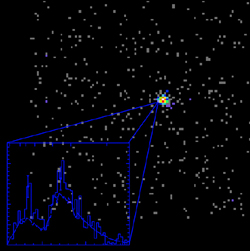The following release was received from the International Center for Relativistic Astrophysics, "ICRA", in Rome, Italy.
Gamma-Ray Bursts May Be Due To Electromagnetic Black HolesJuly 12, 2001
A team of scientists, using data from NASA's Chandra X-ray Observatory on the X-ray afterglow from a gamma-ray burst, has proposed that these mysterious explosions represent the formation of an electromagnetic black hole. This could be the first evidence of the explosive extraction of energy from an electromagnetic black hole.
The team, led by Remo Ruffini now at the University of Rome in Italy, used data from Chandra, the Italian-Dutch Beppo-Sax satellite, and the Rossi-XTE satellite to compare their theory of gamma-ray bursts with the observations. Gamma-ray bursts are cosmic explosions that are observed to produce tremendous amounts of X-rays and gamma rays in a relatively short period of time.
As reported in a pair of papers published in July 10th issue of The Astrophysical Journal Letters, Ruffini and colleagues found that the timing and intensity of the gamma-ray burst as well as the extended X-ray afterglow emission could be explained by their model, which involves the formation of a nonrotating (for simplicity) and electrically charged black hole.
Their charged black hole model is based on the possibility that an extremely strong electric field can be formed in the collapse of a massive star to form a black hole. The energy of this electric field can be converted in a trillionth of a nanosecond into matter and anti-matter electrons. These pairs of matter and anti-matter electrons quickly collide. They create an enormous pulse of energy that expands at near the speed of light and heats the remaining portion of the star that is still outside the black hole to billions of degrees Celsius. The heated matter then expands at nearly the speed of light, producing the explosion that is observed as a gamma-ray burst.
Ruffini and his colleagues computed the detailed evolution of this theoretical fireball and compared it with the X-ray observations of a gamma-ray burst that occurred on December 12, 1999 (GRB 991216). From these calculations, the team determined that the observations could be explained if 99.99 percent of the star's original mass of 22 solar masses had collapsed to form a black hole with a charge of about 10 percent of the theoretical maximum.
"The agreement between the theory and data is excellent," said Ruffini. "Observations of gamma-ray bursts offer an excellent tool for testing the model and these data are indicating that we might be witnessing the formation of electromagnetic black holes and the extraction of their energy."
In 1971, Demetrios Christosdoulous and Ruffini, then at Princeton, calculated that black holes are not just energy sinks, but can also represent the largest energy sources in the universe, each one totaling up to 50% of the mass energy of an electromagnetic black hole. It was Ruffini with Thibau Damour, now the youngest member of the Science French Academy in Paris, who proved while at Princeton in 1975 that the process of creation of matter and anti-matter electrons could extract energy from a black hole.
In a companion paper, also published in The Astrophysical Journal Letters, Ruffini and colleagues advance the idea that the impact of the expanding fireball on a nearby star could, under the right conditions, induce a supernova explosion of that star. They suggest that this would explain the association of some gamma-ray bursts with supernovas and account for details of X-ray emission from iron ions observed by Chandra in GRB 991216 that has been difficult to explain with other models for gamma-ray bursts.
The co-authors on the papers are Carlo Bianco, Federico Fraschetti, and She-Sheng Xue of the University of Rome, and Pascal Chardonnet of the University of Savoie (LAPTH) in France.
MEDIA CONTACTS
Megan Watzke
Chandra X-ray Observatory Center, CfA, Cambridge, MA
Phone: 617-496-7998



